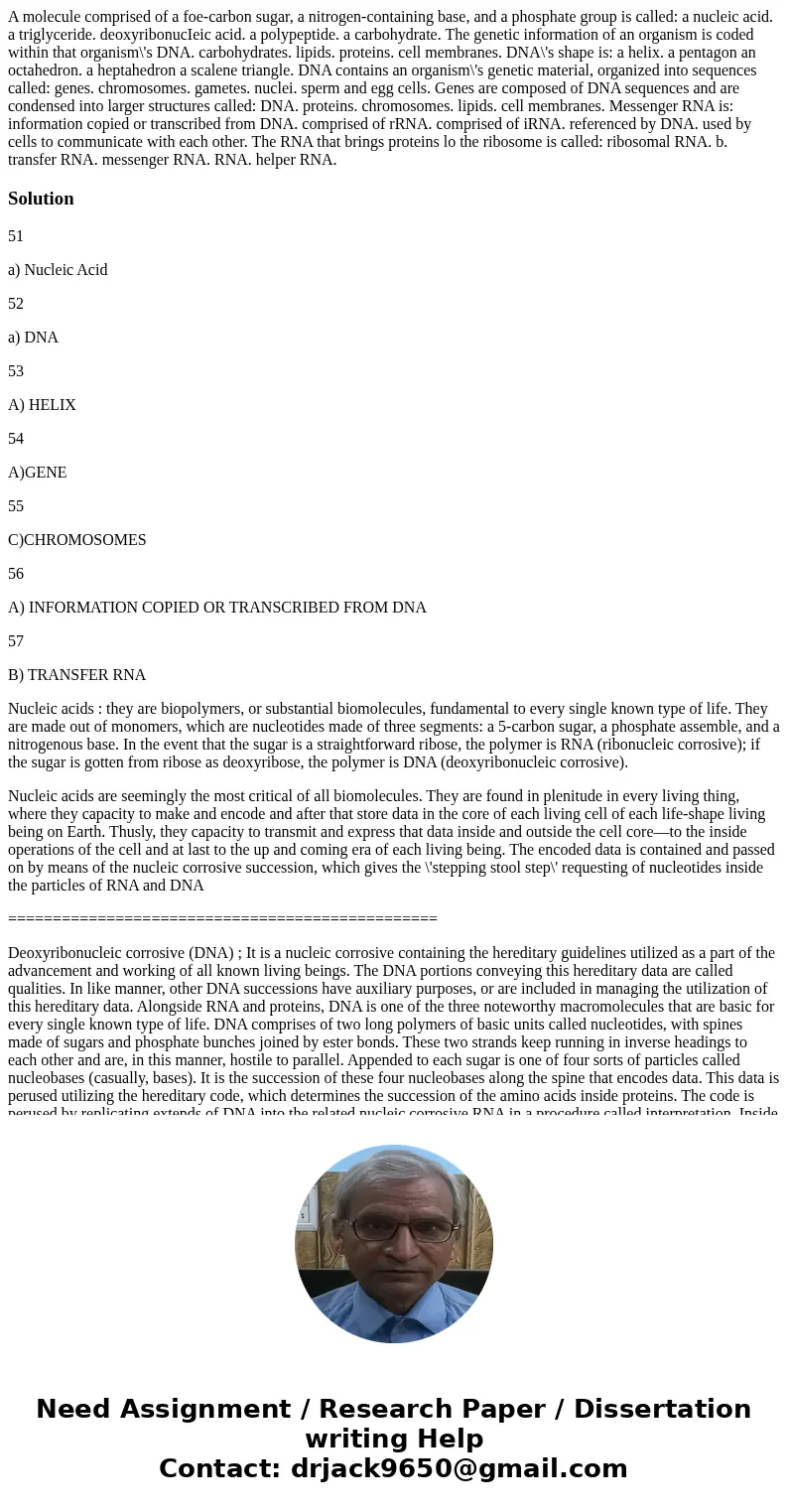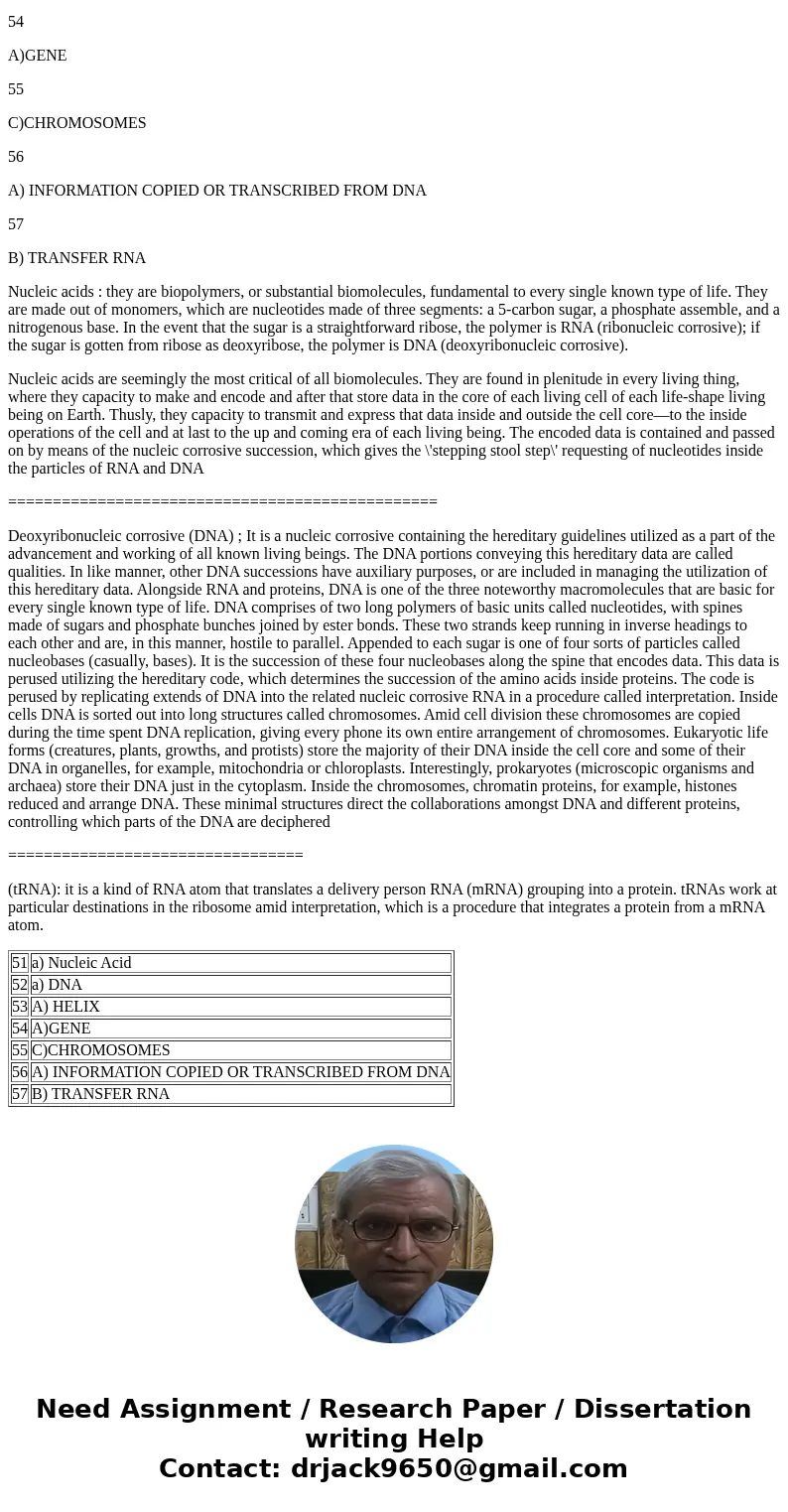A molecule comprised of a foecarbon sugar a nitrogencontaini
Solution
51
a) Nucleic Acid
52
a) DNA
53
A) HELIX
54
A)GENE
55
C)CHROMOSOMES
56
A) INFORMATION COPIED OR TRANSCRIBED FROM DNA
57
B) TRANSFER RNA
Nucleic acids : they are biopolymers, or substantial biomolecules, fundamental to every single known type of life. They are made out of monomers, which are nucleotides made of three segments: a 5-carbon sugar, a phosphate assemble, and a nitrogenous base. In the event that the sugar is a straightforward ribose, the polymer is RNA (ribonucleic corrosive); if the sugar is gotten from ribose as deoxyribose, the polymer is DNA (deoxyribonucleic corrosive).
Nucleic acids are seemingly the most critical of all biomolecules. They are found in plenitude in every living thing, where they capacity to make and encode and after that store data in the core of each living cell of each life-shape living being on Earth. Thusly, they capacity to transmit and express that data inside and outside the cell core—to the inside operations of the cell and at last to the up and coming era of each living being. The encoded data is contained and passed on by means of the nucleic corrosive succession, which gives the \'stepping stool step\' requesting of nucleotides inside the particles of RNA and DNA
================================================
Deoxyribonucleic corrosive (DNA) ; It is a nucleic corrosive containing the hereditary guidelines utilized as a part of the advancement and working of all known living beings. The DNA portions conveying this hereditary data are called qualities. In like manner, other DNA successions have auxiliary purposes, or are included in managing the utilization of this hereditary data. Alongside RNA and proteins, DNA is one of the three noteworthy macromolecules that are basic for every single known type of life. DNA comprises of two long polymers of basic units called nucleotides, with spines made of sugars and phosphate bunches joined by ester bonds. These two strands keep running in inverse headings to each other and are, in this manner, hostile to parallel. Appended to each sugar is one of four sorts of particles called nucleobases (casually, bases). It is the succession of these four nucleobases along the spine that encodes data. This data is perused utilizing the hereditary code, which determines the succession of the amino acids inside proteins. The code is perused by replicating extends of DNA into the related nucleic corrosive RNA in a procedure called interpretation. Inside cells DNA is sorted out into long structures called chromosomes. Amid cell division these chromosomes are copied during the time spent DNA replication, giving every phone its own entire arrangement of chromosomes. Eukaryotic life forms (creatures, plants, growths, and protists) store the majority of their DNA inside the cell core and some of their DNA in organelles, for example, mitochondria or chloroplasts. Interestingly, prokaryotes (microscopic organisms and archaea) store their DNA just in the cytoplasm. Inside the chromosomes, chromatin proteins, for example, histones reduced and arrange DNA. These minimal structures direct the collaborations amongst DNA and different proteins, controlling which parts of the DNA are deciphered
=================================
(tRNA): it is a kind of RNA atom that translates a delivery person RNA (mRNA) grouping into a protein. tRNAs work at particular destinations in the ribosome amid interpretation, which is a procedure that integrates a protein from a mRNA atom.
| 51 | a) Nucleic Acid |
| 52 | a) DNA |
| 53 | A) HELIX |
| 54 | A)GENE |
| 55 | C)CHROMOSOMES |
| 56 | A) INFORMATION COPIED OR TRANSCRIBED FROM DNA |
| 57 | B) TRANSFER RNA |


 Homework Sourse
Homework Sourse